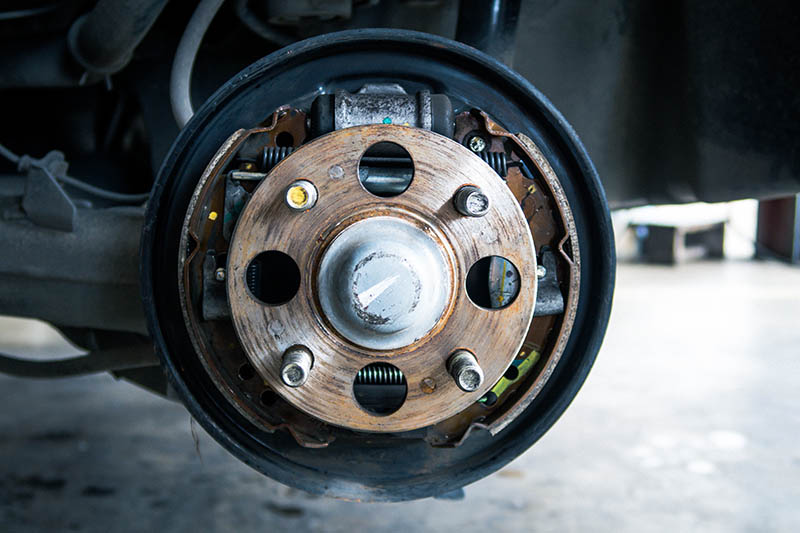What Are Drum Brakes? Pros, Cons, & Types
-

- Last updated:

There are a ton of different components that go into making your vehicle road-worthy, but one component that is critical to your safety but people often overlook is the brakes.
Disc brakes are the most common type of brakes in a vehicle today, but you can still find drum brakes in plenty of cars and trucks. But what exactly are drum brakes, how do they work, and how are they different from disc brakes?
We’ll answer all those questions and more for you below. By the time you finish reading, you’ll know how drum brakes work and even have a better idea of when you need to take them in for servicing!

How Do They Work?
Drum brakes consist of a few critical components that work to stop your vehicle when you hit the brakes. First, there’s the drum. The drum sits over the rest of the brake components, and the outer edge of the inside of the drum is where the pads press into.
The pads themselves sit inside the drum, and when you hit the pedal, the two pads push out in opposite directions to push against the drum. This process creates friction, and this friction is the force that slows down your vehicle.
When you let go of the brake pedal, the springs attached to the pads pull them off the drum and you can go back to driving normally.
What Are the Different Types of Drum Brakes?

While all drum brakes work using the same principles, there are a few different styles that handle things in slightly different ways. The three main types of drum brakes are the leading/trailing shoe-type drum brake, the twin leading shoe-type drum brake, and the duo servo-type drum brake.
The leading/trailing shoe-type drum brake is the most common type of drum brake in smaller passenger vehicles. This system uses a leading brake shoe that travels the same way as the rotating drum. Meanwhile, the trailing shoe drags against the drum. This system uses an anchor pin, and the motion is relative to this. Both pads can become the “leading” or “trailing” pad, depending on whether the vehicle is in drive or reverse.
The next type of drum brake is the twin leading shoe-type drum brake. These systems ditch the single anchor point of the leading/trailing design, and instead, there are two wheel cylinders. This allows for superior braking force, and it’s why you can find this system on the front axle of some trucks.
Finally, you can most commonly find duo servo-type drum brake systems in parking brakes. Both brake shoes connect via an adjuster, providing a considerable amount of braking power. However, this braking power isn’t as easy to control as other options, so it’s not a great choice for regular brake systems.
Where Are They Used?

You can most often find drum brakes in two types of vehicle applications. First, you can typically find them in larger vehicles. This is because drum brakes have a larger surface area than disc brakes, allowing them to handle heavier vehicles more easily. While you could manufacture large enough disc brakes for these vehicles, it would cost quite a bit to do so.
The other application you can often find drum brakes is on the rear axle of some passenger vehicles. This is because rear axles generally provide about 20% of the stopping power for a vehicle.
This means they don’t need to produce as much friction, which is a good thing since drum brakes are generally less effective than disc brakes. But since drum brakes are less expensive to produce, many manufacturers will save a few bucks by putting them on the rear axle.
Advantages of Drum Brakes
There are two primary advantages to drum brakes compared to disc brakes. First, new drum brakes typically cost less to manufacture than disc brakes. Second, drum brakes last longer than disc brakes. This is because drum brakes generate lower amounts of heat when braking, leading to less wear and tear on the brake pads.
Disadvantages of Drum Brakes
While drum brakes last a long time, one major disadvantage they have compared to disc brakes is that they’re not as effective at stopping your vehicle. Disc brakes can apply more pressure to the rotors, and this extra pressure gives them more braking force.
Considering it’s the job of the brakes to stop your vehicle, not being the best at braking is a pretty big disadvantage for drum brakes! Not only that but from a maintenance standpoint, drum brakes are more challenging to change. It’s not a problem for a professional mechanic, but for a DIYer, it can create quite a headache.

Frequently Asked Questions (FAQs)
Brakes are an extremely important part of your vehicle, and after learning a little more about drum brakes, it’s only natural to have a few questions. We understand, and it’s why we wanted to answer some of the most frequently asked questions for you here:
What Is Better: Disc or Drum Brakes?
If you’re looking for the most effective brakes, disc brakes are clearly the way to go. Not only do disc brakes stop a vehicle faster, but they’re also less likely to experience brake fade. The only areas where drum brakes beat disc brakes are price and longevity.
Why Are Disc Brakes More Popular Than Drum Brakes?
Disc brakes are more popular than drum brakes on most modern passenger vehicles simply because they’re more effective. They stop your vehicle faster and are less likely to experience brake fade, making them the safer choice.
How Long Do Drum Brakes Usually Last?

Drum brakes last a long time. A typical drum brake can last between 150,000 and 200,000 miles before you need to change out the pads. Considering the average disc brake lasts about 50,000 miles, that’s a huge advantage for drum brakes.
How Do You Tell if You Need to Replace Drum Brakes?
While you can’t easily visually inspect drum brake pads, there are a few telltale signs you can keep an eye out for:
- Listen if there’s a squealing sound when you hit the brakes.
- Feel if the brake pedal vibrates when you depress it or if it feels loose.
- Your vehicle shakes or pulls to one side when you hit the brakes.
If you notice any of these symptoms, you should inspect the pads on the drum brakes because it might be time to replace them!
A Quick Reference Guide
| Advantages of Disc Brakes | Advantages of Drum Brakes |
| More powerful braking power | They last longer |
| Easier to replace | They cost less |
| Easier to check |

Conclusion
Brakes are one part of your vehicle you never want to take for granted. When they’re working the way that they should, it’s smooth sailing, but if they fail, you’ll notice it quickly. Whether you have drum brakes or disc brakes on your vehicle, ensure they’re getting the service they need to keep you safe when you’re driving down the road!
Featured Image Credit: PongMoji, Shutterstock
Contents
